Abstract
A major problem of tumor gene therapy is the low transduction efficiency of the currently available vectors. One way to circumvent this problem is the delivery of therapeutic genes encoding intracellular enzymes for the conversion of a prodrug to a cytotoxic drug which can then spread to neighboring non-transduced cells (bystander effect). One possibility to improve the bystander effect could be the extracellular conversion of a hydrophilic prodrug to a lipophilic, cell-permeable cytotoxic drug. Toward this end, we have used a secreted form of the normally lysosomal human β-glucuronidase (s-βGluc) to establish an extracellular cytotoxic effector system that converts an inactivated glucuronidated derivative of doxorubicin (HMR 1826) to the cytotoxic drug. We demonstrate that s-βGluc-transduced tumor cells convert HMR 1826 to doxorubicin which is taken up by both transduced and non-transduced cells. s-βGluc in combination with HMR 1826 efficiently induces tumor cell killing both in cell culture and in vivo. This effect is mediated through a pronounced bystander effect of the generated cytotoxic drug. Most notably, this gene therapeutic strategy is shown to be clearly superior to conventional chemotherapy with doxorubicin.
This is a preview of subscription content, access via your institution
Access options
Subscribe to this journal
Receive 12 print issues and online access
$259.00 per year
only $21.58 per issue
Buy this article
- Purchase on Springer Link
- Instant access to full article PDF
Prices may be subject to local taxes which are calculated during checkout





Similar content being viewed by others
References
Ford JM, Hait WN . Pharmacology of drugs that alter multidrug resistance in cancer Pharmacol Rev 1990 42: 155–199
Culver KW et al. In vivo gene transfer with retroviral vector-producer cells for treatment of experimental brain tumors (see comments) Science 1992 256: 1550–1552
Mullen CA, Kilstrup M, Blaese RM . Transfer of the bacterial gene for cytosine deaminase to mammalian cells confers lethal sensitivity to 5-fluorocytosine; a negative selections sytem Proc Natl Acad Sci USA 1992 89: 33–37
Huber BE et al. In vivo antitumor activity of 5-fluorocytosine on human colorectal carcinoma cells genetically modified to express cytosine deaminase Cancer Res 1993 53: 4619–4626
Bridgewater JA et al. Expression of the bacterial nitroreductase enzyme in mammalian cells renders them selectively sensitive to killing by the prodrug CB1954 (published erratum appears in Eur J Cancer 1996; 32A: 186) Eur J Cancer 1995 31A: 2362–2370
Marais R et al. A cell surface tethered enzyme improves efficiency in gene-directed enzyme prodrug therapy Nature Biotech 1997 15: 1373–1377
Paigen K . Mammalian beta-glucuronidase: genetics, molecular biology, and cell biology Prog Nucleic Acid Res Mol Biol 1989 37: 155–205
Rosenfeld MG et al. Biosynthesis of lysosomal hydrolases: their synthesis in bound polysomes and the role of co- and post-translational processing in determining their subcellular distribution J Cell Biol 1982 93: 135–143
Jain S et al. Structure of human beta-glucuronidase reveals candidate lysosomal targeting and active-site motifs Nat Struct Biol 1996 3: 375–381
Bosslet K, Czech J, Hoffmann D . A novel one-step tumor-selective prodrug activation system Tumor Targetting 1995 1: 45–50
Barabas K, Sizensky JA, Faulk WP . Transferrin conjugates of adriamycin are cytotoxic without intercalating nuclear DNA J Biol Chem 1992 267: 9437–9442
Fick J et al. The extent of heterocellular communication mediated by gap junctions is predictive of bystander tumor cytotoxicity in vitro Proc Natl Acad Sci USA 1995 92: 11071–11075
Mesnil M et al. Bystander killing of cancer cells by herpes simplex virus thymidine kinase gene is mediated by connexins Proc Natl Acad Sci USA 1996 93: 1831–1835
Freeman SM et al. The ‘bystander effect’: tumor regression when a fraction of the tumor mass is genetically modified Cancer Res 1993 53: 5274–52783
Bridgewater JA et al. The bystander effect of the nitro-reductase/CB1954 enzyme/prodrug system is due to a cell-permeable metabolite Hum Gene Ther 1997 8: 709–717
Vaupel P, Kallinowski F, Okunieff P . Blood flow, oxygen and nutrient supply, and metabolic microenvironment of human tumors: a review Cancer Res 1989 49: 6449–6465
Tannock IF, Rotin D . Acid pH in tumors and its potential for therapeutic exploitation Cancer Res 1989 49: 4373–4384
Lougerstay-Madec R et al. Synthesis of self-immolative glucuronide-based prodrugs of a phenol mustard Anticancer Drug Des 1998 13: 995–1007
Bakina E, Wu Z, Rosenblum M, Farquhar D . Intensely cytotoxic anthracycline prodrugs: glucuronides J Med Chem 1997 40: 4013–4018
Abina MA et al. Lac Z gene transfer into tumor cells abrogates tumorigenicity and protects mice against the development of further tumors Gene Therapy 1996 3: 212–216
Van Ginkel FW et al. Intratracheal gene delivery with adenoviral vector induces elevated systemic IgG and mucosal IgA antibodies to adenovirus and beta-galactosidase Hum Gene Ther 1995 6: 895–903
Vile RG et al. Systemic gene therapy of murine melanoma using tissue specific expression of the HSVtk gene involves an immune component Cancer Res 1994 54: 6228–6234
Melcher A et al. Tumor immunogenicity is determined by the mechanism of cell death via induction of heat shock protein expression Nature Med 1998 4: 581–587
Barba D, Hardin J, Sadelain M, Gage FH . Development of anti-tumor immunity following thymidine kinase-mediated killing of experimental brain tumors Proc Natl Acad Sci USA 1994 91: 4348–4352
Mullen CA, Coale MM, Lowe R, Blaese RM . Tumors expressing the cytosine deaminase suicide gene can be eliminated in vivo with 5-glurocytosine and induce protective immunity to wild-type tumor Cancer Res 1994 54: 1503–1506
Oshima A et al. Cloning, sequencing, and expression of cDNA for human beta-glucuronidase Proc Natl Acad Sci USA 1987 84: 685–689
Riechmann L, Clark M, Waldmann H, Winter G . Reshaping human antibodies for therapy Nature 1988 332: 323–327
Graham FL et al. A new technique for the assay of infectivity of human adenovirus 5 DNA Virology 1973 52: 456–467
Bosslet K, Czech J, Hoffmann D . Tumor-selective prodrug activation by fusion protein-mediated catalysis Cancer Res 1994 54: 2151–2159
Acknowledgements
We are grateful to Klaus Bosslet for useful discussions, to Claudia Cybon and Tina Stroh for excellent technical assistance, to A Wellstein for the JEG-3 cell line and to M Krause for synthesis of oligonucleotides.
Author information
Authors and Affiliations
Rights and permissions
About this article
Cite this article
Weyel, D., Sedlacek, HH., Müller, R. et al. Secreted human β-glucuronidase: a novel tool for gene-directed enzyme prodrug therapy. Gene Ther 7, 224–231 (2000). https://doi.org/10.1038/sj.gt.3301072
Received:
Accepted:
Published:
Issue Date:
DOI: https://doi.org/10.1038/sj.gt.3301072
Keywords
This article is cited by
-
Real-time imaging of intestinal bacterial β-glucuronidase activity by hydrolysis of a fluorescent probe
Scientific Reports (2017)
-
Bacterial glucuronidase as general marker for oncolytic virotherapy or other biological therapies
Journal of Translational Medicine (2011)
-
Enhancement of CPT-11 antitumor activity by adenovirus-mediated expression of β–glucuronidase in tumors
Cancer Gene Therapy (2011)
-
Membrane-localized activation of glucuronide prodrugs by β-glucuronidase enzymes
Cancer Gene Therapy (2007)
-
Adenoviral vector-mediated expression of a gene encoding secreted, EpCAM-targeted carboxylesterase-2 sensitises colon cancer spheroids to CPT-11
British Journal of Cancer (2005)



